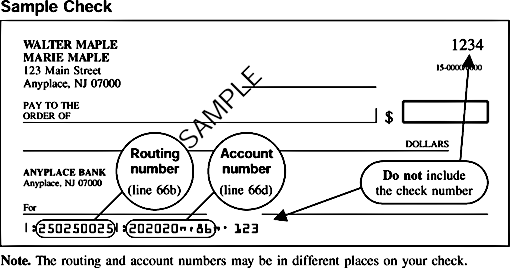Line 68 - Amount You Owe

|
You do not have to pay if line 68 is under $1.
|
Include any estimated tax penalty from line 69 in the amount you enter on line 68.
You can pay by check, money order, or credit card (American Express Card, MasterCard, or Discover Card).
To pay by check or money order, make it payable to the "United States Treasury" for the full amount due. Do not send cash. Write "1999 Form 1040" and your name, address, daytime telephone number, and social security number (SSN) on your payment. If you are filing a joint return, enter the SSN shown first on your tax return.
To help us process your payment, enter the amount on the right side of the check like this: $ XXX.XX. Do not use dashes or lines (for example, do not enter "$ XXX-" or "$ XXX XX/100"). Then, please complete Form 1040-V following the instructions on that form and enclose it in the envelope with your payment.

To pay by credit card, call 1-888-2PAY-TAX (1-888-272-9829) toll-free and follow the instructions. A convenience fee will be charged by the credit card processor based on the amount you are paying. You will be told what the fee is when you call and you will have the option to either continue or cancel the call. You can also find out what the fee will be on the Internet at www.8882paytax.com. If you paid by credit card, enter the confirmation number you were given at the end of the call on page 1 of Form 1040 in the upper left corner.
Do not include any estimated tax payment in your check, money order, or amount you charge. Instead, make the estimated tax payment separately.
You may need to (a) increase the amount of income tax withheld from your pay or (b) make estimated tax payments for 2000. See Income Tax Withholding and Estimated Tax Payments for 2000 on page 51.
What if You Cannot Pay? If you cannot pay the full amount shown on line 68 when you file, you may ask to make monthly installment payments. You may have up to 60 months to pay. However, you will be charged interest and may be charged a late payment penalty on the tax not paid
by April 17, 2000, even if your request to pay in installments is granted. You must also pay a fee. To limit the interest and penalty charges, pay as much of the tax as possible when you file. But before requesting an installment agreement, you should consider other less costly alternatives, such as a bank loan.
To ask for an installment agreement, use Form 9465. You should receive a response to your request for installments within 30 days. But if you file your return after March 31, it may take us longer to reply.
Line 69- Estimated Tax Penalty
You must include household employment taxes reported on line 55 to see if you owe the penalty if line 57 is more than zero or you would owe the penalty even if you did not include those taxes. But if you entered an amount on Schedule H, line 7, include the total of that amount plus the
amount on Form 1040, line 55.
You may owe this penalty if:
- Line 68 is at least $1,000 and it is more than 10% of the tax shown on your return, or
- You did not pay enough estimated tax by any of the due dates. This is true even if you are due a refund.
For most people, the "tax shown on your return" is the amount on line 56 minus the total of any amounts shown on lines 59a and 60 and Forms 8828, 4137, 4136, and 5329 (Parts III, IV, V, VI, and VII only).
Exceptions. You will not owe the penalty if your 1998 tax return was for a tax year of 12 full months AND either of the following applies.
- You had no tax liability for 1998 and you were a U.S. citizen or resident for all of 1998, or
- The total of lines 57, 58, and 62 on your 1999 return is at least as much as the tax liability shown on your 1998 return. Your estimated tax payments for 1999 must have been made on time and for the required amount.
If your 1998 adjusted gross income was over $150,000 (over $75,000 if your 1999 filing status is married filing separately), item 2 above applies only if the total of lines 57, 58, and 62 on your 1999 return is at least 105% of the tax liability shown on your 1998 return. This rule does not apply to farmers and fishermen.
Figuring the Penalty If the Exceptions above do not apply and you choose to figure the penalty yourself, see Form 2210 (or 2210-F for farmers and
fishermen) to find out if you owe the penalty. If so, you can use the form to figure the amount. In certain situations, you may be able to lower your penalty. For details, see the Instructions for Form 2210 (or 2210-F). Enter the penalty on Form 1040, line 69. Add the penalty to any tax due and
enter the total on line 68. If you are due a refund, subtract the penalty from the over-payment you show on line 65. Do not file Form 2210 with your return unless Form 2210 indicates that you must do so. Instead, keep it for your records.
Because Form 2210 is complicated, if you want to, you can leave line 69 blank and the IRS will figure the penalty and send you a bill. We will not charge you interest on the penalty if you pay by the date specified on the bill.
Previous | First | Next
Form 1040 Instructions Main | 1999 Tax Year Archives | Tax Help Archives Main | Home
